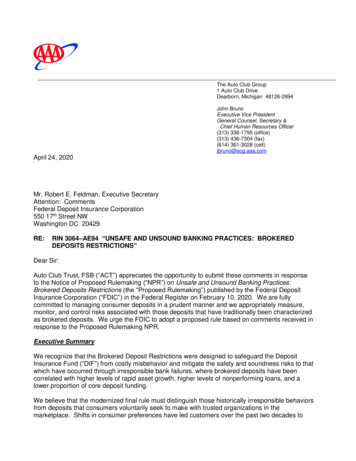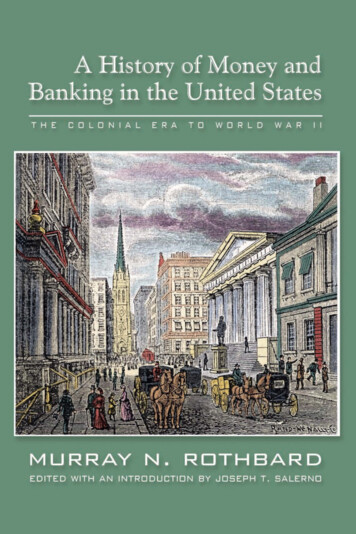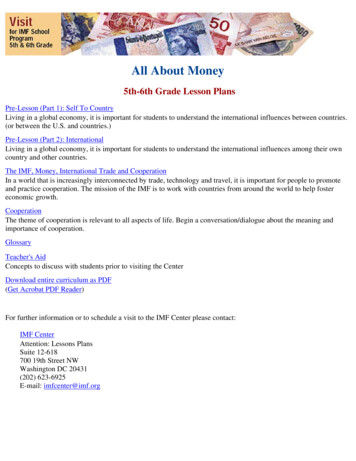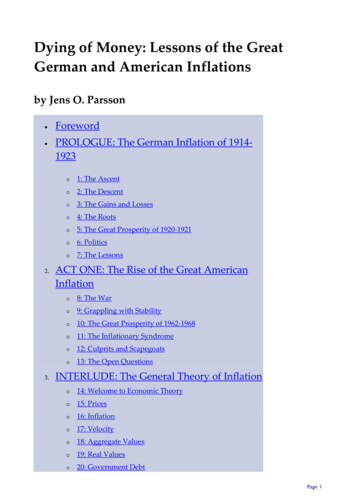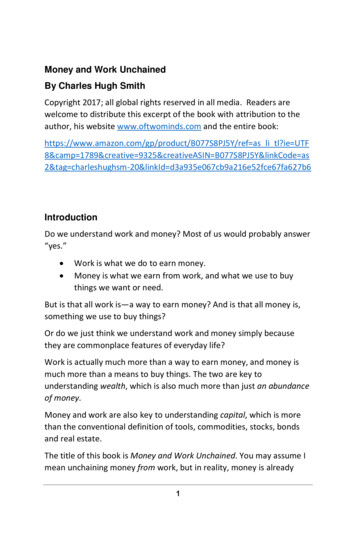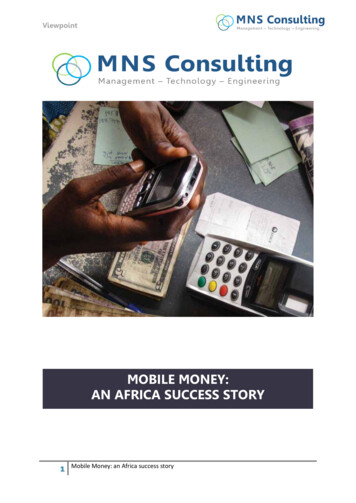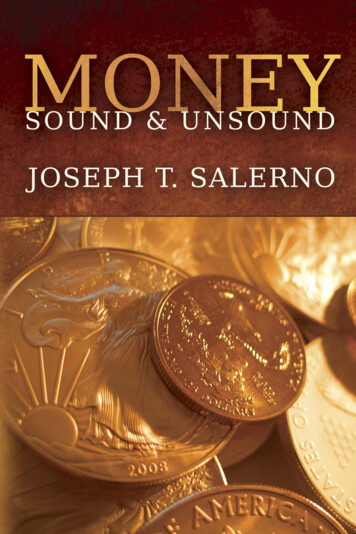
Transcription
Money,Sound and Unsound
The Ludwig von Mises Institute dedicates this volumeto all of its generous donors and wishes to thankthese Patrons, in particular:Frederick L. MaierJohn H. BolstadJ. Robert and Rita BostJohn E. BurgessJeremy and Helen DavisKevin P. DuffyKevin R. GriffinThomas KommerRichard J. Kossmann, M.D.Chauncey L. LarmerJoe R. LeeHunter LewisArnold Lisio, M.D.Ronald MandleJoseph Edward Paul MelvilleWiley L. Mossy, Jr.James M. RodneySheldon RoseThomas S. RossJ.W. Schippmann FoundationDonnie R. Stacy, M.D.Byron StoeserDavid W. TiceQuinten and Marian WardDouglas WyattRobert S. Young
Money,Sound and UnsoundJoseph T. Salerno
2nd printing 2010 by the Ludwig von Mises Institute and published under theCreative Commons Attribution License wig von Mises Institute518 West Magnolia AvenueAuburn, Alabama 36832mises.orgISBN: 978-1-933550-93-0
CONTENTSIntroduction . . . . . . . . . . . . . . . . . . . . . . . . . . . . . . . . . xiAcknowledgements . . . . . . . . . . . . . . . . . . . . . . . . . . . . xiiiPart One:Foundations of Monetary Theory1. Two Traditions in Modern Monetary Theory: JohnLaw and A.R.J. Turgot . . . . . . . . . . . . . . . . . . . . . . . . . 12. Ludwig von Mises’s Monetary Theory in Light ofModern Monetary Thought . . . . . . . . . . . . . . . . . . . . . . 613. The “True” Money Supply: A Measure of the Supplyof the Medium of Exchange in the U.S. Economy . . . . . . . . 1154. A Simple Model of the Theory Of Money Prices . . . . . . . . . 1315. International Monetary Theory . . . . . . . . . . . . . . . . . . . 1536. Ludwig von Mises and the Monetary Approach tothe Balance of Payments: Comment on Yeager . . . . . . . . . . 167v
vi Money, Sound and Unsound / SalernoPart Two:Inflation, Deflation and Depression7. The Concept of Coordination in AustrianMacroeconomics . . . . . . . . . . . . . . . . . . . . . . . . . . . 1818. Ludwig von Mises on Inflation and Expectations . . . . . . . . . 1999. War and the Money Machine: Concealing the Costsof War beneath the Veil of Inflation . . . . . . . . . . . . . . . . 23710. An Austrian Taxonomy of Deflation—with Applications to the U.S. . . . . . . . . . . . . . . . . . . . 26711. Comment on Tullock’s “Why AustriansAre Wrong About Depressions” . . . . . . . . . . . . . . . . . . 315Part Three:The Gold Standard12. The 100 Percent Gold Standard:A Proposal for Monetary Reform . . . . . . . . . . . . . . . . . 32313. Gold Standards: True and False . . . . . . . . . . . . . . . . . . 35514. The Gold Standard:An Analysis of Some Recent Proposals . . . . . . . . . . . . . 37515. The International Gold Standard:A New Perspective . . . . . . . . . . . . . . . . . . . . . . . . . . 403vi
viiContents Part Four:Applications16. Money and Gold in the 1920s and 1930s:An Austrian View . . . . . . . . . . . . . . . . . . . . . . . . . . 42117. Inflation and Money: A Reply to Timberlake . . . . . . . . . . 44118. A Monetary Explanation of the October Stock MarketCrash: An Essay in Applied Austrian Economics . . . . . . . . 44919. Beyond Calculational Chaos: Sound Money and the Questfor Capitalism and Freedom in Ex-Communist Europe . . . . 46720. Preventing Currency Crises: The Currency BoardVersus The Currency Principle . . . . . . . . . . . . . . . . . . 497Part Five:Commentary21. Greenspan’s Empty Talk . . . . . . . . . . . . . . . . . . . . . . 53522. Did Greenspan Deserve Support for Another Term? . . . . . 55523. The Role of Gold in the Great Depression:A Critique of Monetarists and Keynesians . . . . . . . . . . . . 57124. Comment on “A Tale of Two Dollars: Currency andCompetition and the Return to Gold, 1865 – 1879”by Robert L. Greenfield and Hugh Rockoff . . . . . . . . . . . 58125. Money Matters No More? . . . . . . . . . . . . . . . . . . . . . . 59126. Deflation and Depression: Where’s the Link? . . . . . . . . . . 595 Index . . . . . . . . . . . . . . . . . . . . . . . . . . . . . . . . . . . . 603vii
ixIntroduction ACKNOWLEDGEMENTSIwish to thank Douglas French and Jeffrey Tucker, President andEditorial Vice President of the Ludwig von Mises Institute, respectively, for originally suggesting the idea for this book and for theirmoral support and encouragement—and forbearance—during itspreparation. I am especially thankful to the donors of the Mises Institute whose generous support has made the publication of this volume a reality. My greatest intellectual debt is to my dear friend andmentor Murray Rothbard. Throughout his brilliant career he was anarticulate, courageous, and intransigent proponent of sound money.Of course, Mises and Hayek also profoundly influenced my thinking, and I learned much from the works of William H. Hutt, HenryHazlitt, Hans Sennholz, Jacques Rueff, Michael Heilperin, WilhelmRöpke, and Benjamin Anderson. All were fearless and outspokenadvocates of sound money during the high tide of Keynesianism.I am indebted to my many colleagues who have read and commented on various drafts of these essays and whose articles and booksin the sound money paradigm have taught and inspired me over theyears. Although far too numerous for me to properly acknowledgehere, they include Walter Block, William Butos, John Cochran, RogerGarrison, Jeffrey Herbener, Hans-Hermann Hoppe, Jesús Huerta deSoto, Jörg Guido Hülsmann, Antony Mueller, Gary North, GeorgeReisman, Pascal Salin, the late Larry Sechrest, the late Sudha Shenoy,Frank Shostak, Mark Thornton, Lawrence H. White, and, of course,the polymathic David Gordon. I am especially grateful to LlewellynH. Rockwell, Jr. founder and Chairman of the Mises Institute whohas steadfastly supported and encouraged all of my writing projectsand has provided an institutional home for the modern sound moneymovement. Several of the essays collected in this book were presentedix
x Money, Sound and Unsound / Salernoas papers at New York University Colloquium on Market Institutionsand Economic Processes (formerly, the Austrian Economics Colloquium), and I thank its members for their cogent suggestions andcriticisms. Last but not least, I owe a great debt of gratitude to Helenand Michael Salerno, who suffered through my long absences, periods of distraction, and occasional irritability while these essays werebeing written. This is a debt that cannot easily be repaid.
xiIntroduction INTRODUCTIONThe twenty-six essays collected in this book were published overthe last three decades in a variety of academic journals, scholarly books, policy report series, and periodicals aimed at thenon-specialist. Several were originally published in electronic periodicals. They share a common theme despite the fact that they were written at different times and for disparate audiences. This theme may bebroadly summed up in the term “sound money” as defined by Ludwigvon Mises. According to Mises:[T]he sound money principle has two aspects. It is affirmative in approving the market’s choice of a commonly usedmedium of exchange. It is negative in obstructing the government’s propensity to meddle with the currency system. Sound money meant a metallic standard. The excellence ofthe gold standard is to be seen in the fact that it renders thedetermination of the monetary unit’s purchasing power independent of governments and political parties.1The idea of sound money was present from the very beginningof modern monetary theory in the works of the sixteenth-centurySpanish Scholastics who argued against debasement of the coinageby the king on ethical and economic grounds.2 The concept of sound1Ludwig von Mises, The Theory of Money and Credit, 2nd ed. (Irvington-on-Hudson, New York: Foundation for Economic Education, 1971), pp. 414–16.2 Jesús Huerta de Soto, “New Light on the Prehistory of the Theory of Banking andthe School of Salamanca,” Review of Austrian Economics, 9, no. 2 (1996): pp. 59–81;idem, “Juan de Mariana: The Influence if the Spanish Scholastics,” in Randall G. Holcombe, ed., 15 Great Austrian Economists (Auburn, Ala.: Ludwig von Mises Institute, 1999), pp. 1–12; and Jörg Guido Hülsmann, The Ethics of Money Production(Auburn, Ala.: Ludwig von Mises Institute, 2008); and Alejandro Chafuen, Faith andxi
xii Money, Sound and Unsound / Salernomoney, or “sound currency” as it was then called, was central to thewritings of David Ricardo and his fellow “bullionists” in the earlynineteenth century who argued that the price inflation observed inGreat Britain during and after the Napoleonic Wars was caused bythe suspension of the convertibility of bank notes into gold and silvermandated by the British government.3 The ideal of the bullionists was“a self-regulating currency” 4 whose quantity, value and distributionamong nations were governed exclusively by market forces of supplyand demand.The sound money doctrine reached the peak of its influence inthe mid-nineteenth century after another great debate in Great Britainbetween the “currency” school and the “banking” school. Supportersof the “currency principle” favored a monetary system in which themoney supply of a nation varied rigidly with the quantity of metallicmoney (gold or silver) in the possession of its residents and on depositat its banks. Their banking school opponents upheld the “bankingprinciple,” according to which the national money supply would beadjusted by the banking system to accommodate the ever fluctuating“needs of trade.” The currency school prevailed in the short run withthe passage of Peel’s Act of 1844. But although the currency principlewas basically sound, its policy application was considerably weakenedby two serious errors committed by its proponents. First, they failedto include demand deposits in the money supply, along with metallic coins and bank notes. Thus while they insisted that every newissue of bank notes was to be backed 100 percent by gold, they did notapply the same principle to the creation of new checking deposits. Theresult was that the money supply was still free to vary beyond the limits imposed by international gold flows thus subjecting the economyto continued recurrence of the inflation-depression cycle.Liberty: The Economic Thought of the Late Scholastics, 2nd ed. (New York: Lexington Books, 2003).3 On the bullionist controversy, see Murray N. Rothbard, Classical Economics: AnAustrian Perspective on the History of Economic Thought Volume II, pp. 157–224and the literature cited therein.4 David Ricardo, 1838, p. 22.
Introduction xiiiThis error in the currency school program was compoundedby a second one that further undermined its ultimate goal of soundmoney and rendered the economy even more susceptible to cyclical fluctuations. Thus the currency school proposed that the Bank ofEngland, a governmentally privileged bank with a quasi-monopolyof the note issue, oversee the application and enforcement of the currency principle. Of course a monopoly bank with such close ties togovernment would have both the incentive and influence to engineerdepartures from the principle during a financial panic in order to prevent a widespread bank run that would threaten its own gold reserves.To avoid a general loss of confidence in the banking system, it neededto expand its own supply of notes in order to lend to shaky privatebanks that did not have sufficient reserves to meet their own depositors’ demands for redemption. This is exactly what occurred as Peel’sAct was routinely suspended during panics, effectively guaranteeingan inflationary bailout of the banks in future crises and intensifyingtheir inflationary propensity. Peel’s Act thus did not moderate or abolish the business cycle and, indeed, came to be viewed as an impediment to the Bank of England operating as a lender of last resortduring crises. As a result, the currency principle was thoroughly discredited and the ideal of sound money was badly tarnished.The early opponents of the sound money principle, such as theanti-bullionists and the banking school, were nearly all naïve andunsophisticated inflationists who either confused money with wealthor believed that real economic activity was being stifled by a chronicscarcity of money. But in the late nineteenth century a new and muchmore sophisticated opposition to sound money began to develop during the debate over the bimetallic standard, a monetary system inwhich both gold and silver served as money with their exchange ratefixed by legal mandate. The bimetallic standard had functioned as thelegal (if not always the de facto) standard for most major countriesexcept Great Britain from the beginning of the nineteenth centuryuntil the 1870s, when silver was officially demonetized by the U.S.,France, Italy, Switzerland, Belgium, the Scandinavian countries, andthe newly created German Empire.
xiv Money, Sound and Unsound / SalernoThe proponents of the bimetallic standard argued for remonetization of silver on the grounds that this measure would increase themoney supply and thus arrest the decline in prices under the monometallic gold standard that had begun in the late 1870s. The quantitytheory of money was the foundation of the arguments put forward bythe bimetallists. The theoretical counter-arguments of the advocatesof the monometallic gold standard were completely inadequate tomeet the challenge posed by the quantity theorists. They were basedon the view that the costs of production of mining gold directly determined the price level, a distortion of classical monetary theory developed by Ricardo and the currency school.5 Paradoxically, althoughthe gold standard remained intact, at least for the short run, the seedsfor its eventual abolition had been sown because the classical soundmoney doctrine had been discredited among economists.As David Laidler, a modern proponent of the quantity theory,commented:[T]he refinement of the quantity theory after 1870 did notstrengthen the intellectual foundations of the Gold Standard.On the contrary, it was an important element in bringingabout its eventual destruction. [T]he notion of a managedmoney, available to be deployed in the cause of macroeconomic stability and capable of producing a better economicenvironment than one tied to gold, was not an intellectualresponse to the monetary instability of the post-war period.The idea appeared in a variety of guises in the pre-war literature as a corollary of the quantity theory there expounded.6Thus by the end of the nineteenth century the view that moneyshould ideally be “stable” in value had fully displaced the classicalideal of “sound” money, meaning a commodity chosen by the marketwhose value was strictly governed by market forces and immune to5On the error of the late nineteenth-century monometallists of interpreting classical monetary theory as involving strictly a cost-of-production theory of the valueof money, see Will E. Mason, Classical Versus Neoclassical Monetary Theories: TheRoots, Ruts, and Resilience of Monetarism—and Keynesianism, ed. William E.Butos (Boston: Kluwer Academic Publishers, 1996).6 David Laidler, The Golden Age of the Quantity Theory (Princeton: Princeton University Press, 1991), p. 2.
Introduction xvmanipulation by governments. This new view culminated in the workof Irving Fisher, who in 1911 formalized the quantity theory in mathematical terms and proposed it as a formula for use by politicians andbureaucrats charged with the task of managing money in the interestsof stability of the price level.7 Indeed, it was Fisher and not Keynes whowas the true founder of modern macroeconomics with its aggregativereasoning and its central notion of politically managed fiat money.8 Asthe modern monetary theorist and historian of thought, Jürg Niehanswrote:Fisher’s reformulation of the quantity theory of money hassuccessfully survived seventy-five years of monetary debatewithout a need for major revision; its analytical content isaccepted today by economists of all persuasions, and in thepresent world of fiat money it is actually more relevant than itwas in Fisher’s gold standard world.9Such was the state of monetary economics when Mises publishedhis seminal work on The Theory of Money and Credit, in 1912.10 Inwriting this book, Mises achieved two aims. The first was to reconstruct monetary theory by integrating it with the subjective-valuetheory of price which had been developed by the early Austrian economists, most notably Carl Menger and Eugen Böhm-Bawerk. By doingthis Mises was able to resolve the so-called “Austrian Circle,” accordingto which the value of money could not be explained in terms of marginal utility because any such explanation involved circular reasoning.It was this misconception that opened the door to Fisher’s analysis ofmoney in terms of aggregative variables such as the national moneysupply, velocity of circulation of money, the average price level, and so7 Irving Fisher, The Purchasing Power of Money, Its Determination and Relation toCredit, Interest, and Cycles, 2nd ed. (New York: Macmillan, 1922); also idem, TheMoney Illusion (New York: Adelphi Company, 1928).8 Cf. Mark Thornton, “Mises vs. Fisher on Money, Method, and Prediction: TheCase of the Great Depression,” Quarterly Journal of Economics 11 (2008): 230–41.9 Jürg Niehans, A History of Economic Theory: Classic Contributions, 1720–1980(Baltimore, Md.: The Johns Hopkins University Press, 1994), p. 278.10 Ludwig von Mises, The Theory of Money and Credit, trans. H.E. Batson, 3rd ed.(Auburn Ala.: Ludwig von Mises Institute, 2009).
xvi Money, Sound and Unsound / Salernoon, eventually leading to the unquestioned predominance of the macroeconomic quantity theory of money.Mises’s second accomplishment was to revive the currencyschool’s sound money doctrine and correct its shortcomings by severing its ties with the classical cost-of-production theory of value andgrounding it in modern monetary theory. Friedrich A. Hayek, Mises’sprotégé, further developed the theoretical foundations of the soundmoney doctrine in works published in the 1920s and early 1930s.11Unfortunately, Mises’s and Hayek’s ideas on sound money wereignored, and the stable money doctrine continued in ascendancy afterWorld War One. The Federal Reserve and other central banks instituted a regime of managed money and central bank “cooperation”during 1920s that stifled the natural operation of the gold standard.In the U.S., in particular, the Fed engineered a rapid and prolongedexpansion of the money supply through the fractional-reserve banking system driving interest rates below the “natural” or equilibriumrate and precipitating bubbles in stock and real estate markets. However the inflationary monetary policy was not recognized by most ofthe American economics profession who were quantity theorists andstabilizers like Fisher. They focused almost solely on movements inwholesale or consumer prices, which remained basically unchangedduring the 1920s. Under a sound money regime these prices wouldhave dropped dramatically to reflect the increased abundance ofgoods that resulted from the extremely rapid growth in productivityand real output that occurred during the decade.12The ultimate effect of the central banks’ manipulation of themoney supply and interest rates was the onset of the Great Depression.Mises and Hayek had been led by their analyses to anticipate such an11 The most important of these works are collected in F.A. Hayek, Prices and Production and Other Works: F.A. Hayek on Money, the Business Cycle, and the GoldStandard, ed. Joseph T. Salerno (Auburn, Ala.: Ludwig von Mises Institute, 2008).12 On the inflation of the 1920s and the remarkably profound and widespread influence of the stabilizationist idea on Anglo-American economists, bankers, monetarypolicymakers, and politicians during this period, see Murray N. Rothbard, America’s Great Depression, 5th ed. (Auburn, Ala.: Ludwig von Mises Institute, 2000), pp.85–135, 165–81.
Introduction xviioccurrence.13 Writing in 1932, the eminent Harvard economist andinternational monetary expert John H. Williams summarized the Austrians’ position and noted their forecast of the depression:It can be argued but that for credit expansion prices wouldhave fallen, and that they should have done so. It was onsuch grounds that the Austrian economists predicted thedepression.14In contrast to the Austrians, the stabilizers, especially Fisher,were surprised and totally befuddled by the event. But Hayek knewexactly where to place the blame, writing in 1932:We must not forget that, for the last six or eight years, monetary policy all over the world has followed the advice ofthe stabilizers. It is high time that their influence, which hasalready done harm enough, should be overthrown.15The stable money doctrine was soon discredited, only to bereplaced by the vastly more inflationary spending doctrine propounded by John Maynard Keynes, himself a former advocate of stable money. In its essentials, Keynes’s doctrine harked back to JohnLaw and the so-called “monetary cranks” of the nineteenth century.Keynes maintained that depression was simply the result of a deficiency of total spending or “aggregate demand,” which was a chroniccondition of the market economy. The only remedy for this problem, he argued, was government budget deficits that directly injectedmoney spending into the economy combined with an expansionarymonetary policy to lower interest rates and stimulate private investment spending. The Keynesian spending doctrine achieved unchallenged dominance in academic economics in the U.S. and GreatBritain shortly after World War Two and by the 1960s was settled13 See Mark Thornton, “Mises vs. Fisher on Money, Method, and Prediction”; andidem, “Uncomfortable Parallels,” www.LewRockwell.com (April 18, 2004). Also see,Mark Skousen, The Making of Modern Economics: The Lives and Ideas of the GreatThinkers (Armonk, N.Y.: M.E. Sharpe, 2001), pp. 291–93.14 John H. Williams, “Monetary Stabilization and the Gold Standard,” in QuincyWright, ed., Gold and Monetary Stabilization (Chicago: University Press, 1932), p. 149.15 Hayek, Prices and Production and Other Works, p. 7.
xviii Money, Sound and Unsound / Salernodoctrine among economic policymakers, who eagerly implementedcheap-money and deficit-spending policies.These policies eventually resulted in the accelerating inflation ofthe 1960s followed by the chronic stagflation of the 1970s. Like theearlier stable-money policies, aggregate demand policies led to consequences that were completely unexpected by their advocates andcould not be explained within the Keynesian framework. By the late1970s, Keynesianism as a policy program had lost its credibility andit was supplanted by monetarism, a movement led by Milton Friedman which had been growing in influence in academic economicssince the early 1960s. But monetarism was nothing more than Fisher’sstable money principle supported by a seemingly more sophisticatedversion of the quantity theory of money restated in Keynesian terminology. Instead of aiming directly at a stable price level, Friedman andthe monetarists advocated that the central bank aim at stabilizing thegrowth of the money supply at a rate consistent with a zero or lowlong-run rate of inflation. Events soon falsified monetarist predictionsof price and output movements during the mid-1980s, and orthodoxmonetarism rapidly declined in influence in academia and, especially,in the policy arena.By the early 1990s, a new theoretical consensus in macroeconomics had emerged known as New Keynesian economics, whichsynthesized elements of Keynesianism, monetarism, and New Classical economics, an offshoot of monetarism.16 The policy goal ofthis consensus remained stable money, or at least a low and stablerate of inflation. Although the Greenspan Fed did not articulate thisgoal explicitly, the central bank operated in a way consistent with itthroughout the 1990s and consumer price inflation remained moderate and remarkably stable as growth of real output accelerated.Beginning in 1995, a financial boom developed centered on technology stocks. Financial writers, media commentators, economists on16N. Gregory Mankiw and David Romer, eds., New Keynesian Economics, 2vols. (Cambridge, Mass.: MIT Press, 1991). For a short description, see N. Gregory Mankiw, “New Keynesian Economics,” in David R. Henderson, ed., The Concise Encyclopedia of Economics, 2nd ed., available at http://www.econlib.org/library/CEETitles.html.
Introduction xixWall Street and in academia, and even Alan Greenspan himself beganto refer to the “New Economy” to designate the combination of lowinflation, rapid productivity and output growth and a booming stockmarket that marked the latter half of the 1990s. Blinded by the fallacious stable money doctrine which focused narrowly on consumerprice indexes, they all ignored the huge increase in the money supply that had fueled the boom. But once again the goal of stable moneyproved to be chimerical as the Dot-com bubble burst and the economyplunged into a short-lived recession in 2001. The Fed quickly pumpedthe economy out of the slump with a new burst of monetary expansion driving the Fed Funds rate down to 1 percent from 6.5 percentby mid-2003 and maintaining it at that level for a year. The recovery offinancial markets and the speed up in economic growth by 2003 alongwith a continuing moderation of consumer price inflation allayedmost doubts about the inflationary thrust of Fed policy and restoredconfidence in the stable money program. Still there were a handful ofcritics who warned that a massive housing bubble was forming as earlyas 2003, but they were ignored or ridiculed as “doomsayers” or “goldbugs.” Most were either Austrian economists or bankers and financialcommentators who had discovered and were influenced by the soundmoney tradition of Mises, Hayek and Rothbard.17Despite their recent experience with the meltdown of the 1990sNew Economy, the stable money enthusiasts inside and outside theeconomics profession were incorrigible and proclaimed that the economy had passed into a new era of long-run stability in the economybeginning in the mid-1980s. This new era they dubbed “The GreatModeration.” The term was even used as the title of a speech deliveredin 2004 by then Federal Reserve Board Governor and leading macroeconomist Ben Bernanke.18 Another leading light of macroeconomics17On Austrians who forecast a housing bubble in 2003–2004, see Mark Thornton,“The Economics of Housing Bubbles,” in Randall G. Holcombe and Benjamin Powell, eds., Housing America: Building Out of a Crisis (New Brunswick, N.J.: Transaction Publishers, 2009), pp. 237–62.18 Ben S. Bernanke, “The Great Moderation,” speech delivered at the meetings of theEastern Economic Association, Washington, D.C. (February 20, 2004), available /2004/20040220/default.htm.
xx Money, Sound and Unsound / SalernoRobert Lucas declared in 2003, “[the] central problem of depressionprevention has been solved, for all practical purposes.” 19The whole notion of the Great Moderation trumpeted by establishment macroeconomists was uncannily reminiscent of the “NewEra” of permanent prosperity proclaimed by Fisher and other stable money economists in the 1920s. The dawning of both eras wasattributed to the adoption of new and improved money managementtechniques by the Fed. As was the case in the 1920s and the 1990s,however, the relative stability of the price level misled the stabilizersinto ignoring or denying the growth of dangerous asset bubbles. Thusthe Great Moderation ended in the spectacular deflation of the stockmarket and real estate bubbles followed by the financial crisis andstunning collapse of several iconic financial institutions. In the U.S.,the crisis culminated in the longest recession since World War Two.After the latest debacle caused by the stable money program,almost all mainstream macroeconomists were compelled to abandonthe mathematical models and policy prescriptions of New Keynesianism in their search for an explanation and a remedy. They beat aheadlong retreat straight back to old-fashioned Keynesianism withits emphasis on investor irrationality, wayward financial markets andthe pervasive tendency of the public to “hoard.” The recovery policesthat they now recommended were designed to pump up spendingthrough deficit financing and a zero interest rate. Several eminentmacroeconomists even advocated the deliberate creation of inflationary expectations among the public as a legitimate tool of monetarypolicy.20 They argued that spending would be stimulated if people19Robert E. Lucas, “Macroeconomic Priorities,” Presidential Address to the American Economic Association (January 10, 2003), p. 1. Available at http://home.uchicago.edu/ sogrodow/homepage/paddress03.pdf.20 See for example Paul Krugman, The Return of Depression Economics and the Crisis of 2008 (New York: W.W. Norton & Company, Inc., 2009); N. Gregory Mankiw,“The Next Round of Ammunition,” Greg Mankiw’s Blog: Random Observationsfor Students of Economics (December 16, 2008), available at of-ammunition.html; Kenneth Rogoff quotedin Rich Miller, “U.S. Needs More Inflation to Speed Recovery, Say Mankiw, Rogoff,”Bloomberg.Com (May 19, 2009) available at http://www.bloomberg.com/apps/news?pid 20601109&sid auyuQlA1lRV8.
Introduction xxiwere convinced that the value of their money “would melt a
The idea of sound money was present from the very beginning of modern monetary theory in the works of the sixteenth-century Spanish Scholastics who argued against debasement of the coinage by the king on ethical and economic grounds.2 The concept of sound 1 Ludwig von Mises, The Theory of
